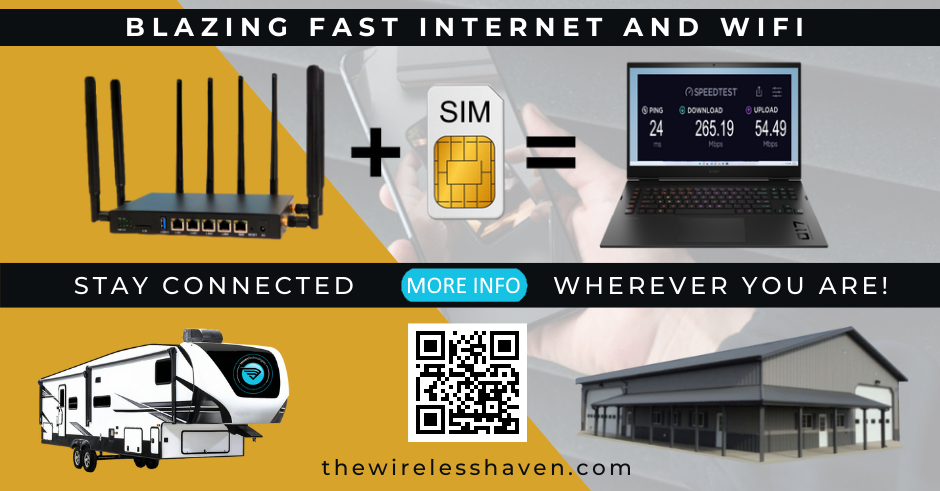Some history:
- I've tried fixed wireless in the distant past, but, without line of site to the tower, results were mediocre.
- More recently I've used DSL. But the quality of the copper is poor. It works well part of the time but has packet loss and high latency the other part of the time. Probably noisy corroded copper interconnects. I've had the AT&T tech out multiple times to no avail.
- I've also tried an AT&T hotspot (ZTE MF279), also with poor results. Added an external 20 ft antenna (but didn't understand MIMO at the time, so only one antenna). Then tried a booster. All variants have had noise based latency and packet loss problems.
- Most recently got a MOFI 4500 SIM4 (also in ignorance) to obtain better low level access to the modem. This has been instructive, but I'm still having the same problems.
- But! Driving around the neighborhood with the MOFI has shown that better connectivity is possible. Unfortunately I live in a small valley. Thus...
Raising the Tower. The tower is hinged by removing 4 of 6 bolts at the base. Universal's instructions are to walk the tower up by hand, but I'm skeptical this will work for a 70 ft tower. Also I would like to lower and raise the tower single-handed and so I'm planning to configure a winching system. I've whipped up a [url=http://www.diligentsoftware.com/test/tower.html]web page[/url] to model the loads on the tower at various geometries and tower angles. Turns out that the highest tension is experienced while the tower is flat on the ground. Moving the gin pole (where the pulley is attached to) closer to the base of the tower helps. Increasing the gin pole height reduces tension but increases gin pole torque. Anyway, current plan is to locate the tower close to the back of my garage which will give me the equivalent of a gin pole 11 ft tall offset from the hinge about 9 ft. Maximum tensions experienced are around 1400 lbs and how to safely attach the cable to the tower is "to be determined".
Antennas. Currently planning on using two Bolton Technical's UltraGain 26 Directional Antennas in a 2x2 MIMO configuration. I'm not sure if I need this much gain, but I'm willing to over specify to ensure project success. The count of line of site cellular towers (from the perspective of the top of tower) is around 5 for T-Mobile (my current SIM) ranging in distance from 3.5 to 10 miles. The tower with the most bands available is also the closest but also more populated and so maybe more congested. We'll see how things look once everything is set up.
Pointing. These antennas are highly directional; between 7 and 20 degrees for a half powered signal depending on frequency. There is no good way to hand point the antennas from 70 feet below, so a rotator is required. I'm considering the Alfa Spid RAK rotator but the stock controller looks dated. An upgraded RT-21 controller from Green Heron improves the situation with a built in power supply, better acceleration/deceleration control, and maybe 1/10 degree of precision. Not 100% sure about the precision as this is still an open research topic.
Feedline. The LTE modem will be stowed in an equipment box at the base of the tower so requires about a 70 ft feedline run. Originally I was considering relatively standard LMR400. But LMR600 looks even better (and more expensive). And for about the same price as LMR600 I can also get Andrew Heliax LDF4-50A. How do these compare? For a 70' run and an 1800Mhz signal: LMR400 has 3.99 dB, LMR600 2.59 dB, and LDF4-50A has 2.15 dB of attenuation. Is the performance gain (52% better attenuation, or 60% efficiency vs 40% efficiency) worth the cost? I don't know. But if a 50' LMR400 run is acceptable than a 75' LDF4 run should also be acceptable.
Some additional feedline notes:
- Frequency range is important. It would be nice to upgrade to Sub 6Ghz 5G someday. LDF4 can do 8.8Ghz while LMR600 can only do 5.8Ghz and LMR400 can do 6Ghz.
- Alas, millimeter band 5G seems out of "reach" without moving the modem closer to the antennas. I haven't found any coaxial feedline that can do > 24Ghz frequencies for a significant distance. (Side note: I keep seeing mention that 5G millimeter band only has a range of several hundred meters. But I find this hard to believe as satellites hundreds of miles up often use Ka band to communicate with the ground.)
- More flexible coax is needed through the rotator. LMR-400-UF UltraFlex might work here as it has a braided core.
- Lots of N connectors will be needed as they have a built in weather seal.
Modem. I'm going to continue with the MOFI 4500 SIM4 for now. It's possible a higher category modem would improve carrier aggregation and available bands. For T-Mobile I'll be missing B66 and B71, but very few modems support B71 yet. I'm starting with a T-Mobile SIM, but ATT might be a good option to try once the dust settles. I would be wildly thrilled if it appears that I'm bumping into MOFI's 100Mbps ethernet limitation. A future upgrade might be a CAT12 or CAT20 modem paired with a Raspberry PI 4. Or maybe 5G modems will become affordable one day?
Power for the modem will be provided from within the residence via PoE rated at a sufficient amperage.
Summary. I'm trying to retire as much risk as possible through research and design. I'm tired of naive solutions that disappoint. I'll try and keep this thread up to date as the project progresses.
Opinions & Ideas welcome!
edit: formatting


